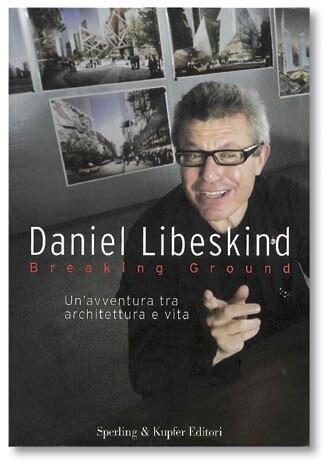Breaking Ground. Un’avventura tra architettura e vita Daniel Libeskind, Sperling & Kupfer, Milano 2005 (pp. 275, € 19,00)
In this piece of writing, as on other occasions, Daniel Libeskind repeatedly declares an aversion for an idea of the discipline that considers above all the quantity of production and a mistaken concept of professionalism. He also underlines the importance of operating beyond customary procedures, attempting to penetrate a world of mystery, passion and adventure through architecture. The dynamics of construction, he says, are now placed in a field that looks at social and political history more than any linguistic or functional necessity. The whole of his work therefore necessarily deals with a variety of issues, which nevertheless presents a logical direction and path.
In actual fact, for him the interest lies in this path more than in individual projects, because if the aims are undetermined and not yet clearly known, it is above all the coherence of this procedure that nourishes what is only imagined and allows the realisation of things yet to be built. In the text, Libeskind successfully manages to restore the balance in the relationship between personal autobiographical events and the consequent reflections and choices taken towards architecture, which he demonstrates to have reached through complex and varied routes of life, study and thought. Born into a family of Polish immigrants, as a young man in New York after a period in Israel, he came to architecture abandoning both his musical education and deep interest in drawing to follow his mother’s admonition that “architecture is a paid job, as well as a form of art,” and that “you can always do art with architecture, but you can’t do architecture with art”.
It was a considered choice of “profession” first extensively experienced as a continual theoretical experimentation and speculation, in research and teaching, up to the competition and appointment for the Jewish Museum in Berlin. On this occasion he defined architecture as “the art of compromise”, referring to the very long times (in this case 12 years) necessary for the planner to complete the work without giving up the spirit and intentions of the project. The book describes the events of those years in detail, for this realisation as for the Ground Zero reconstruction competition. The same can be said for the other works now typical of a formal language that critics are unable to define beyond the simple description of broken lines, blades of light, walls that challenge any orthogonal criterion, from the Denver Art Museum to the Imperial Art Museum in Manchester, from the new wing of the Victoria and Albert Museum in London to the Royal Ontario Museum and the recent proposal for the upgrading of Milan’s Fiera exhibition centre area, here amply illustrated.
Considered a master of creating buildings that reflect the characteristics of their times, which he intimately understood and interpreted through a very personal spirituality, Libeskind says about his architecture: “I am inspired by light, sound, invisible spirits, the clear consciousness of place and respect for history. We are all shaped by a combination of reality and incorporeal forces, and to have a spiritual echo, the buildings have to reflect these.” He rarely describes his buildings in an analytical fashion, but rather, as Paul Goldberger wrote (The New Yorker, 15/09/2003), “he presents his work as if it were done by someone else, seeing it for the first time and finding it fantastic”. In other words he tries to tell its history in an enthusiastic and participatory way, the ideas, the emotions, the meaning of the metaphors and how they are translated into the architectural act. More than describing the many designed museums’ structures and functional articulation, he prefers to say that “a museum is not only a container to be filled with treasures, but a place where people must question themselves as to their future spaces”.
In the many public debates following the presentation of the Ground Zero projects, he never gave a detailed illustration of his proposal, describing instead the conceptual and symbolic motivations that inspired it. He did this with the conviction that it must not be understood as an expression of the architect’s ego but rather of the people’s expectations. He tells of his descent into the excavation’s enormous crater up to the containment wall of the Hudson, which the design leaves in view as a historical and symbolic reference, of how he reread the Declaration of Independence, the Constitution and the poetry of Walt Whitman.
He shows his 1,776-foot-high Freedom Tower seen from the sea next to the Statue of Liberty, the contemporary image of his first impression as a thirteen-year-old boy at the sight of New York’s skyline. This is not a monograph but, as the subtitle says, “an adventure through architecture and life”. It revives Libeskind’s interest in a way of communicating the intentions and meaning of architecture according to a personal approach that has often divided the critics and even aroused open opposition. Some regard this desire to present his work through symbolic, spiritual and elusive elements as a new language that reinterprets his time in the light of cultural experiences and historical events of the last century, communicating an idea of architecture that aims at the “liberation of space” (Marc Schoonderbeek).
Others, such as Goldberger, accuse him of speaking the sentimental language of the “middle American”, or they speak ironically, for example Robert Stern when he affirms that “Daniel is a preacher, and that always makes me a little nervous”. Even Peter Eisenman, who was his teacher at the Cooper Union and dedicates much attention to Libeskind’s Berlin Museum in his course at Princeton, ruthlessly commented that he “has transformed from obscure experimenter to renowned architect, and any theory is possible on what history draws from him”.
Gianni Pettena Professor of History of Architecture at Florence University


